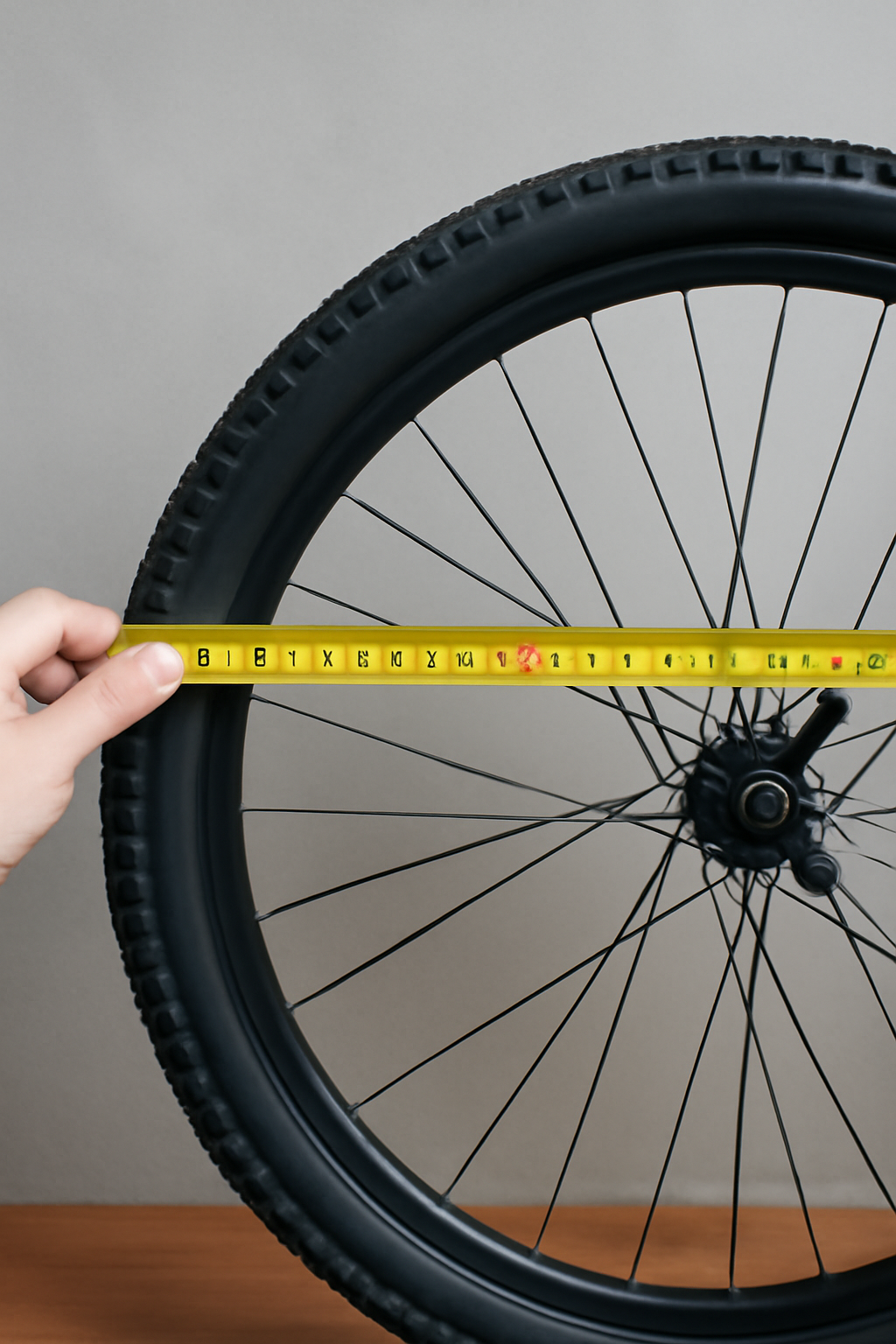Whether you’re replacing tires that are worn out or replacing your bike parts, bicycle wheel size measurement is important in order to get the optimal performance, comfort, and safety. The right bicycle wheel size will play a significant role in determining your cycling experience, affecting speed to handling.
Accurate bike wheel measurement allows you to select the right rim and tires, ensuring a comfortable ride. If you are unaware of your bike’s wheel size, you risk choosing the wrong tires, which can compromise your bike’s performance and safety. In this tutorial, we’ll walk you through how to measure a bicycle wheel size accurately for maximum results.
In this guide, we’ll walk you through how to measure bicycle wheel size accurately for the best results.
2. How to Interpret Different Bicycle Wheel Sizes: An in-depth Guide
Wheel sizes on bikes differ based on the nature of the bike and the intended application, and therefore it is important to understand the appropriate size for your riding purpose. Road bikes ride on 700c wheels, which are perfect for long rides on smooth roads. Mountain bikes do come in different wheel sizes, such as 26″, 27.5″, and 29″, which each offer advantage to off-road terrain and rideability. Wheels for hybrid, city, and kids’ bikes may also vary, with the 700c or smaller options ideal for comfort and handling. Knowing the different wheel sizes on a bike enables you to pick the best wheel size for your riding condition and style, thereby enhancing performance and safety.
3. The Equipment You Need to Measure Your Bicycle Wheel Size Accurately
To get accurate measurements of your bicycle wheel size, a few simple tools will do the trick to get the job right. One of the easiest tools to employ in measuring bicycle wheel size is a ruler or measuring tape. These devices allow you to measure your outer wheel rim to rim. Tire markings can be of convenient application while taking bicycle wheel measurements, especially when checking the size written on the sidewall. Calipers may be employed for precise measurement. For the sophisticated user, there are digital tools and software that facilitate the measurement of bicycle wheel size with ease and precision.
4. Step-by-Step Guide to Measuring Bicycle Wheel Diameter
The primary measurement of a bike wheel’s size is its diameter, and you should measure it carefully for tire compatibility.
Key Points:
Outer Diameter: Rim-to-rim measurement with tire for total wheel size.
Rim Diameter: Measure the rim only if you desire the actual rim size, minus the tire.
Diameter Difference: Note the difference between rim diameter and wheel’s overall diameter.
Example Diameter: 622mm is rim diameter for 700c wheel; 559mm is rim diameter for 26-inch wheel.
Preciseness: Exact measurement is crucial to ensure the tire and run smoothly.
5. Tire Size and Its Connection to Bicycle Wheel Size
Tire size plays an integral role in determining your bicycle’s overall performance, and understanding tire markings will help you choose the right size.
Key Points:
Tire Width and Diameter: Tire size affects ride quality, with wider tires providing more stability.
Tire Markings: Learn to decode common tire markings (e.g., 700x25c, 26×2.1).
Tire Sizing Systems: Understand the ISO and ETRTO sizing systems for consistent measurements across different brands.
Compatibility: Ensure tire size matches your wheel size to prevent issues with performance and safety.
Reading Sidewall Markings: How to use tire markings to choose compatible tires for your bike.
6. Conversion Among Different Units of Measurement of Bicycle Wheel Size
Bicycle wheel sizes can be measured in both millimeters and inches, and knowing the conversions between systems will have you confidently selecting the correct parts in no time.
Key Points:
Inch to Millimeter Conversion: Convert standard inch sizes to millimeters (i.e., 26″ to 559mm, 700c to 622mm).
ISO and ETRTO: Familiarize yourself with the millimeter-based systems (ISO/ETRTO) and their conversions from standard inch sizes.
Conversion Charts: Use conversion charts to easily convert between systems of measurement.
Practical Examples: Convert common wheel sizes like 26″ to 559mm, 700c to 622mm, and more for tire and rim compatibility.
Importance of Conversion: Accurate conversion ensures proper tire fitment and avoids mistakes when ordering parts.
7. Measuring Bicycle Wheel Size from Your Bike Frame
If it’s not feasible for you to measure the wheel, you can still determine your bike‘s wheel size by looking at the frame and other associated parts.
Key Points:
Frame Specs: Check your bike’s frame manufacturer specifications to find out if they have any suggested wheel sizes.
Fork and Brake Calipers: Note the measurements of your fork and brake caliper as references to estimate the wheel size.
Frame Markings: Check your bike frame for size markings on wheels.
Consulting Resources: If in doubt, refer to your bike shop or make use of online resources to confirm frame and wheel size suitability.
Frame Size and Wheel Fit: Ensure frame and wheel size match up for effective performance and safety.
8. Common Mistakes to Avoid When Measuring Bicycle Wheel Size
Taking your bicycle wheel size is an easy enough task, but there are some frequent mistakes to be aware of in order to provide an accurate and good fit.
Key Points:
Tire Width Overlooked: Do not overlook the consideration of tire width, which affects the overall wheel size.
Rim Diameter Confusion: Do not confuse the rim diameter with the entire wheel diameter.
Tire Pressure Influence: Tire pressure has a trivial influence on wheel size, affecting measurements.
Tire and Rim Compatibility: Ensure that your tire is compatible with both your rim and wheel size to avoid issues.
Deceptive Measurements: Measure using precise tools and techniques to avoid deceptive wheel size readings that impact performance.
9. How to Choose the Right Bicycle Wheel Size for Your Type of Riding
Selecting the ideal bicycle wheel size is critical in optimizing your ride, and the correct choice depends on your preferred biking style and the terrain.
Key Points:
Road Bikes: When speed and smoothness are desired, 700c wheels are the best choice for road bikes.
Mountain Bikes: Choose the proper size in terms of off-road ability—26″, 27.5″, or 29″ wheels.
Hybrid and City Bikes: Ideal wheel sizes for comfort and commuting are typically 700c or 27.5″.
Kids’ Bikes: Wheel sizes like 12″, 16″, or 20″ are best for younger riders, ensuring safety and ease of use.
Terrain Consideration: Match your wheel size to the terrain (e.g., rough trails for mountain bikes, paved roads for road bikes) for optimal comfort and performance.
Conclusion
With this newfound knowledge of proper bicycle wheel measurement, you are now free to choose the right components for your bike trip. Whether tire replacement, rim upgrade, or making adjustments to improve the performance of your bicycle, precise bicycle wheel size measurement is the way to go.Taking the time to measure correctly ensures that you select the right wheels and tires, enhancing comfort, safety, and efficiency. With the skills to measure your wheel size, you’ll be equipped to make better choices and enjoy a smoother, more enjoyable cycling experience on any terrain.

I am Ryan Ford, a mountain biking enthusiast who loves to explore the outdoors. I also like to go on adventures with friends and anything else that involves being outside. I love my bike because it gets me out of the house and gives me an opportunity to enjoy nature.

